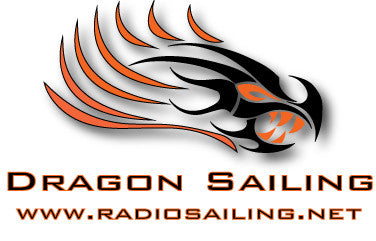
A Dragons Tale / The ‘How’ and ‘Why’ of DF Radio Sailing by John Tushingham
Ever wonder how the DF Classes got started, Lead DF designer and guru, John Tushingham, explains it all !
Before I get into the ‘how did it happen’ I need to explain why it even happened in the first place. This means going back to the winter of 2004 when I’d been looking for the right way to get back into sailing, bought a Laser Vortex, a fresh, new dinghy design that was catching on a my local club. Quickly discovered that it wasn’t suited to me, or rather, I wasn’t suited to it. Had a look at Finns, always fancied one, but one look at the complexity of the top boats rather put me off, but I still kept scanning the event reports on the Yachts & Yachting magazine’s website here in the UK. In early February I spotted something rather interesting, a winter series for quarter scale, radio controlled Lasers being held at West Lancs Yacht Club, famous for it’s twenty four hour annual dinghy race, and being run by a name I recognised from way back. I hadn’t been there since my youthful days as a dinghy sailor, so Liz and I decided to take a drive, partly for nostalgic reasons and to have a look at these RC Lasers. I used to sail a full sized one and Liz used to sell them to us. So we found ourselves at the lake and, from a distance, watched these little boats race. It looked like fun so we went down and introduced ourselves, within five minutes of shaking hands we each had a transmitter in our hands and the countdown timer was on. Several races later we were hooked, found out there was a national series and a national championship, but didn’t know anything else about radio sailing, in fact I’d never really heard of it! We ordered two boats and collected them at the next event two weeks later. Our dealer, Andy Kissick, had fully rigged one for us and explained all the little tips needed to get the best out of it - what service!
We had many great years racing the Lasers, but we’d also discovered the other classes and the garage was starting to fill up with our ever increasing fleet. The build up still continues and I’ve actually lost count of what’s in there now! However, that easy introduction to the sport that has taken over our lives has always stuck with me, the initial publicity, the readily available boats and the service that Andy provided is surely the right way to get more people into our sport. The further I got into other classes and experienced the long waiting lists for new equipment, the more I realised this was the way forward.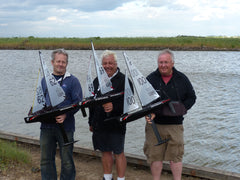 I wasn’t the only one who thought this way, Mike Weston, now of RC Yachts fame, the go-to DF outlet in the UK, often discussed this over many red wine and cheese fuelled evenings. What we needed was a well designed, plastic, one design yacht with three rigs, probably made in the far east, that could be offered at a price unheard of previously and be available off the shelf, fully built. Great idea, but we didn’t have the funds or the contacts to make it happen. I put this idea to quite a few of the top UK sailors at the time and was amazed at the almost total lack of interest, perhaps they were happy just racing IOMs, A Class and Marbleheads and didn’t feel the need to develop an easy entry into the sport. A disappointing response, we still held on to the idea but didn’t have any plan to make it happen, even it it could be done we realised what a politically hot potato it could be.
I wasn’t the only one who thought this way, Mike Weston, now of RC Yachts fame, the go-to DF outlet in the UK, often discussed this over many red wine and cheese fuelled evenings. What we needed was a well designed, plastic, one design yacht with three rigs, probably made in the far east, that could be offered at a price unheard of previously and be available off the shelf, fully built. Great idea, but we didn’t have the funds or the contacts to make it happen. I put this idea to quite a few of the top UK sailors at the time and was amazed at the almost total lack of interest, perhaps they were happy just racing IOMs, A Class and Marbleheads and didn’t feel the need to develop an easy entry into the sport. A disappointing response, we still held on to the idea but didn’t have any plan to make it happen, even it it could be done we realised what a politically hot potato it could be.
Time went by and Mike was busy running his leisure park and doing very good business building race spec Micro Magics and selling a range of RC sailing components. In autumn 2011 he was looking for a cheap RC yacht to sell at the park. One of his suppliers, Ripmax, carried a range of Yachts made by a company called Joysway, they had a little yacht, the Caribbean, that seemed to fit the bill and he made enquiries. Ripmax’s John Wesley made contact and brought down their entire range of Joysway RC yachts for Mike to evaluate and give feedback as to wether they were any good or not. Mike spotted the opportunity and in December fixed up a meeting with John at the park and invi ted myself and Mark Dicks along to demonstrate some RG65s and discuss the Joysway yachts. It probably took John about ten seconds when he saw the performance of the RGs to make up his mind to propose a new yacht design to Joysway, drawn up by a group of ‘experts’ in the UK, his description, not ours!
ted myself and Mark Dicks along to demonstrate some RG65s and discuss the Joysway yachts. It probably took John about ten seconds when he saw the performance of the RGs to make up his mind to propose a new yacht design to Joysway, drawn up by a group of ‘experts’ in the UK, his description, not ours!
As well as being a customer, John was also a trusted advisor to Joysway, helping them to develop the right products for western markets. So, on his advice things began to move quickly, a meeting with the three of us was held in mid December where John gave us the good news that Joysway would produce a new yacht. Then he dropped the bombshell on us, they were shelving a current project and needed a prototype boat in China in five weeks - What! Mild panic ensued, but we realised we already had a boat that we could base it on, Mark’s RG65 design ‘ICE’. Of course, Mark was in favour of it and we squared it up with the current builder of the carbon racing version and packed up my lovely new carbon ICE and shipped it over to Germany where Joysway were exhibiting at the massive, annual Nuremberg Toy Fair. Mike went over to meet them and I go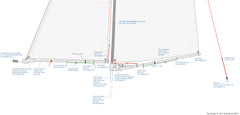 t busy producing many sheets of drawings to specify everything necessary to build a decent boat. After that we were entirely in their development engineers hands, we didn’t know them very well and they didn’t really know us, but it was happening!
t busy producing many sheets of drawings to specify everything necessary to build a decent boat. After that we were entirely in their development engineers hands, we didn’t know them very well and they didn’t really know us, but it was happening!
If we’d had more time to design and develop the boat it might have been a very different product, perhaps 750mm in length, or somewhere between an RG65 and the IOM. But we didn’t have that luxury and that was probably not such a bad thing. Mark and myself were, and still are, keen supporters of the RG65 class, but like the other established classes it was suffering from a restricted supply of new boats, if Joysway could make a hull to the specification we gave them it might just be a cheap, available introductory boat for the RG class.
We had a n anxious wait when all we could do was twiddle our thumbs, tap pencils on desks and keep checking our emails as their engineers translated our 2D design work into a production ready 3D model, would it be any good? A few months went by and as the time past our confidence took a bit of a battering. Finally, at the end of April the inbox pinged and there it was in all it’s 3D rendered glory. Sure, there where obvious things that needed changing, but what a good position to start from, their design for the keelbox structure impressed us greatly, clearly we were working with the right people.
n anxious wait when all we could do was twiddle our thumbs, tap pencils on desks and keep checking our emails as their engineers translated our 2D design work into a production ready 3D model, would it be any good? A few months went by and as the time past our confidence took a bit of a battering. Finally, at the end of April the inbox pinged and there it was in all it’s 3D rendered glory. Sure, there where obvious things that needed changing, but what a good position to start from, their design for the keelbox structure impressed us greatly, clearly we were working with the right people.
Joysway’s normal lead time from concept to production is around nine months, allowing for shipping time the boat was due to be on sale late 2012. So there we were, early May 2012 with a lot still to do if the boat was to hit the market in the shape it needed to be in to be taken seriously. It was the start of many, many emails and reports to Joysway that have become a very significant part of my life ever since. It’s quite a lengthy process detailing the alterations we wanted, reviewing and reporting on what they were send through, but eventually it was push the button time and Joysway could then get started on the production tooling. At this stage we had started to build up a good working relationship, we had no prior experience in dealing with a Chinese company (I should point out that Joysway is actually a Hong Kong based company with production facilities on the nearby Chinese mainland), but John Wesley was always at our shoulder and without his early help things might not have gone as smoothly. It’s no good simply asking for something to be changed, you have to support that request with a full explanation as to why it needs doing, they can then appreciate what you’re asking for and are happy to make the changes. They really do care about the quality of design and construction and have continued to support the boats in this way ever since and have always absorbed the cost of modifications themselves, we couldn’t really ask for better product support from the manufacturer.
It was the start of many, many emails and reports to Joysway that have become a very significant part of my life ever since. It’s quite a lengthy process detailing the alterations we wanted, reviewing and reporting on what they were send through, but eventually it was push the button time and Joysway could then get started on the production tooling. At this stage we had started to build up a good working relationship, we had no prior experience in dealing with a Chinese company (I should point out that Joysway is actually a Hong Kong based company with production facilities on the nearby Chinese mainland), but John Wesley was always at our shoulder and without his early help things might not have gone as smoothly. It’s no good simply asking for something to be changed, you have to support that request with a full explanation as to why it needs doing, they can then appreciate what you’re asking for and are happy to make the changes. They really do care about the quality of design and construction and have continued to support the boats in this way ever since and have always absorbed the cost of modifications themselves, we couldn’t really ask for better product support from the manufacturer.
At some point in September 2012 the DHL delivery man man rang the doorbell and handed over a big brown box! here they were, no longer just a drawing and our first chance to handle the real thing. By this time we knew what the final retail price would be, when we first heard the proposed pricing our collective jaws hit the ground, it was almost half of what we expected, if the boat lived up to it’s promise and sailed well it would be way, way cheaper than any decent racing yacht before it truly would be the boat we dreamed of all those years ago. In a perfect world it would have been job done, sign it off and get on with production, and not too far behind schedule. Unfortunately life’s not like that, it was so nearly there but not everything worked as intended, so it was back to the drawing board for some of the components. But those were minor details compared to the big issue - weight! The target overall sailing weight was approximately 1050g incorporating a keel bulb weight of 550g. At that kind of weight it would be a reasonably competitive RG65, but these first sample boats tipped the scales at a shade under 1400g, it was never going to be a light weather flyer but I’m not sure it would have got far past the starting line in anything under a thirty miles per hour gale. It was strong though! Clearly it had to go on a crash diet, first to go was the full length threaded stainless rod running down the keel with heavy screw on fixings top and bottom, this was replaced by threading the ends of the tube running through the keel and using much smaller bolts at either end. This was a good start but clearly the hull moulding itself needed to shead a lot of weight. By early November the second prototype arrived, much lighter but perhaps a little too thin in certain parts.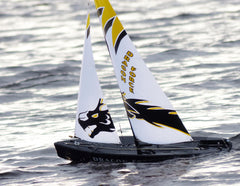 You might have seen this boat sailing in an early YouTube video I posted (search YouTube for “Dragonforce prototype” and you should find it). I can’t remember the exact weight of this hull but a compromise somewhere between the two samples should give us the best blend of performance and durability. Another long report followed detailing all changes needed to bring it up to production specification. December 2012 and the production boat was signed off, Joysway displayed a couple of production spec boats on their stand at the Nuremberg Toy Fair in February 2013 and the expected ‘on sale’ date was May 2013. Over the winter we had chance to test various B and C rig configurations whilst Joysway produced the final tooling for everything.
You might have seen this boat sailing in an early YouTube video I posted (search YouTube for “Dragonforce prototype” and you should find it). I can’t remember the exact weight of this hull but a compromise somewhere between the two samples should give us the best blend of performance and durability. Another long report followed detailing all changes needed to bring it up to production specification. December 2012 and the production boat was signed off, Joysway displayed a couple of production spec boats on their stand at the Nuremberg Toy Fair in February 2013 and the expected ‘on sale’ date was May 2013. Over the winter we had chance to test various B and C rig configurations whilst Joysway produced the final tooling for everything.
Unfortunately John Wesley died in the spring of 2013 and never got to see the launch of the boat he opened the door for us to do. We miss him, and in his honour we named the UK DF65 National Championship trophy in his memory and were delighted that his family came along to the inaugural championship in the autumn of that year to present it.
The all up sailing weight of the production boat ended up at 1250g including an allowance of 50g for a battery pack, so it wasn’t quite where we wanted it in comparison to top level RG65s. That was a slight disappointment, but we had to be realistic about it, we had been given the chance to get a into production, at no expense, other than a considerable amount of time, to ourselves, and in the process had formed a good relationship with Joysway. It is, after all, their product but they were prepared to listen, trust us and make, nearly all, the changes we asked for. During the final prototype testing we had a big decision to make, given the weight of the boat do we go ahead and bring it to market as a class legal RG65, or just brand it as a DragonForce and mention in the details that it does conform to the RG65 rules. 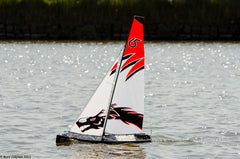 We didn’t want to raise expectation that you would be buying a top level RG, and eventually decided that it still had a useful role to fill as a very inexpensive introduction to the class, after all, it is constructed to allow the fitment of a swing rig and also has deck eyes positioned for taller, high aspect conventional rigs. So it stayed with the RG65 branding and we’d wait to see what the owners wanted to do with it when they started to sail them. We also knew it had great potential as a restricted class and we needed to formulate a simple set of rules for that purpose ready for when the boat went on sale. Without those being available from launch we could foresee the urge for some owners to tinker with it, and at that stage it would have been very hard to pull it back into line as a restricted class.
We didn’t want to raise expectation that you would be buying a top level RG, and eventually decided that it still had a useful role to fill as a very inexpensive introduction to the class, after all, it is constructed to allow the fitment of a swing rig and also has deck eyes positioned for taller, high aspect conventional rigs. So it stayed with the RG65 branding and we’d wait to see what the owners wanted to do with it when they started to sail them. We also knew it had great potential as a restricted class and we needed to formulate a simple set of rules for that purpose ready for when the boat went on sale. Without those being available from launch we could foresee the urge for some owners to tinker with it, and at that stage it would have been very hard to pull it back into line as a restricted class.
Why did we make it a restricted class rather than a true one-design?
Well, you have to remember that it is a Joysway owned product and they had a fairly fixed idea of how it should be presented in terms of graphic appearance, hence the dragon printed sails. We did lobby for plain white ones but it had to have a certain showroom appeal! Not our taste but hey, did it really matter. We realised that had the rules been written on a one-design basis then you would have been forced to stick with the standard sail and we knew that one area Joysway would struggle to match the accepted standard for racing equipment would be the sails, that’s why they’re a single panel design supported by simple measurement rules, and opened up for anyone to make. Not only does this allow for some personalisation but more importantly, if the boat became a commercial success, would not exclude other sailmakers from benefitting from and supporting the class. I think it was a decision well made and I don’t think we’d be where we are now had it been restricted.
Writing the DF65 class rules was not a job to rush, but a lot more straightforward, I imagine, than formulating a set of rules for a new development class. Start from the premise that everything is to be used as supplied and rigged as shown in the instruction manual and then work out two things; how to resist peoples natural urge to improve the boats performance, real or imagined, through small ‘tweaks’ here and there, secondly, to eliminate the need for certification or event measurement where possible. Wrap all that up in plain English - sounds easy! I always have one test for the rules and keep it in mind when any amendments are required. Image you’re new to the sport, you’ve seen DF65s racing at your local lake, you’re amazed how affordable they are and that you can have one immediately. a day or so later you’re opening the box and getting stuck in to rigging your new boat, you follow the instructions to the letter (wishful thinking), then the big day arrives, you get down to the lake, everyone shakes hands, welcomes you aboard but start to point out that you could have done this or that so much better than it says in the instructions, you’ll be ok today but you need to go back and practically rebuilt it - how would it make you feel? That explains why some of the restrictions in the rules might seem a bit over the top and we have to give a frequent “No” answer to most enquiries as to whether this or that little tweak is permitted.
The DF65 and RG65 relationship
I’ve already covered the reasons why the DF65 was introduced as an RG65, but following the boats eventual UK launch in August 2013 we decided race it within the RG65 class and wait to see how things developed. We had the DF65 class rules published at launch which gave us the ability to award a prize for the first DF, it became an unofficial sub class of the RG65. Turnouts began to rise and everything was ok until the RG65 nationals in 2014, we sailed as one mixed fleet as usual, but the entry had reached a level where we had to run as a two fleet event under the HMS system. Conditions were mixed and a few of the top DFs always made it into the A fleet, but the bulk of the DFs could not compete with the lightweight thoroughbreds and remained in B fleet. It split the racing for the Dragons and affected the results, there was a unanimous feeling amongst the DF sailors that there should be a dedicated DF65 racing series and championships, as well as participation at RG events. It was a controversial decision in the UK to form the DF65 class, not as far as the DF owners were concerned, but others saw it as a dishonourable action, they’re entitled to that opinion, but given the growth of the DF since then it would have been inevitable at some point. I’m happy to say that there is still a DF presence at RG events and the RG65 class has grown in the UK in recent years with a significant number of owners who participate in both classes. Despite the DF having the ability to carry swing rigs and taller conventional rigs I don’t see any desire to experiment in that way, but the DF65 will continue to have that facility built in.
The DF65s big brother, the DragonFlite 95
In it’s first full year on sale three thousand seven hundred DF65s had been shipped and Joysway were, understandably very happy. Our working relationship with them continued to flourish and we got to know the owner, his family and the rest of the team very well on a personal level as well. 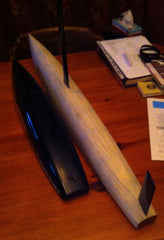 They had tasted success in the radio sailing field and wanted to make an ABS constructed IOM yacht and turned to us to design it for them. Bad idea, it took a lot of persuading that they needed to leave the IOM class alone and respect it’s position as a development class that sits at the top level of our sport. Even it it were possible to produce a competitive plastic boat, the IOM did not need, or want, a mass produced boat, the class has a life of it’s own and a balance that seems to work. But I had been thinking of a big brother for the DF65, but designed to a very different brief.
They had tasted success in the radio sailing field and wanted to make an ABS constructed IOM yacht and turned to us to design it for them. Bad idea, it took a lot of persuading that they needed to leave the IOM class alone and respect it’s position as a development class that sits at the top level of our sport. Even it it were possible to produce a competitive plastic boat, the IOM did not need, or want, a mass produced boat, the class has a life of it’s own and a balance that seems to work. But I had been thinking of a big brother for the DF65, but designed to a very different brief.
I’d raced Marbleheads and you can’t help but be impressed with their windward performance - in a straight line! The rest of their sailing characteristics leave me bit frustrated, they don’t turn corners very well and are far too easily nosedive downwind. Why is this? You have to look at the development of the Marblehead, the hull has always stayed the same length but the rig height and keel length have have grown out of all proportion, the rules have been changed over time to allow this. The Marblehead, as it stands today, is now effectively a big powerful boat with a short hull length, quite the opposite of how it started out, and there’s the problem, downwind it can’t accelerate as quickly as it needs to to avoid tripping up over it’s long, heavy keel and the tall rig only makes things worse. In a strong breeze to windward, unless you have the stiffest carbon tube available, you end up applying a lot of kicker tension to counteract excessive mast bend, so as you go through a tack the rig is unloaded and the mainsail leech becomes bar tight, making it very hard to accelerate out of the tack as you fight the boat’s urge to luff into the wind. If you could dial out those issues you’d have a truly wonderful boat to race.
We all know that hull length is one of the key components of good boat speed, so what would happen if we stretched out the DF65 to one metre long and kept with the same keel, rudder and rig. In January 2014 Joysway had agreed to the development of a bigger yacht and we had a full year in which to work on and deliver the final design to them in person at the 2015 Nuremberg Toy Fair - game on!  The initial prototype was a very radical boat, Mark Dicks drew up the hull lines of a one metre long boat with a maximum width of only one hundred millimetres. I had a wooden planked hull made locally and it was fitted with a fixed DF65 fin and rudder. It did carry a heavier, nine hundred gram keel bulb and had a larger rig, whilst the standard DF65 A rig slotted in nicely as a B rig. It looked a bit weird but it would give us some idea if the idea of a long waterline, lightweight design carrying a relatively small, low aspect rig would work. The first few times we got to sail it was in B rig conditions and it was a revelation, well balanced, tracked very well to windward, downwind it was absolutely amazing, so fast with almost no wake and eerily silent, it looked like you were fast forwarding the video. The acceleration was so rapid that it had almost no tendency to nosedive despite it’s slim hull, it fact it seemed to pick up it’s bow and just get on with it.
The initial prototype was a very radical boat, Mark Dicks drew up the hull lines of a one metre long boat with a maximum width of only one hundred millimetres. I had a wooden planked hull made locally and it was fitted with a fixed DF65 fin and rudder. It did carry a heavier, nine hundred gram keel bulb and had a larger rig, whilst the standard DF65 A rig slotted in nicely as a B rig. It looked a bit weird but it would give us some idea if the idea of a long waterline, lightweight design carrying a relatively small, low aspect rig would work. The first few times we got to sail it was in B rig conditions and it was a revelation, well balanced, tracked very well to windward, downwind it was absolutely amazing, so fast with almost no wake and eerily silent, it looked like you were fast forwarding the video. The acceleration was so rapid that it had almost no tendency to nosedive despite it’s slim hull, it fact it seemed to pick up it’s bow and just get on with it.
All the signs were looking good, until the first outing in lighter winds with the larger rig. It was awful, the small DF65 fin was obviously stalling out at low speed and to windward the balance was all the place, almost unsailable.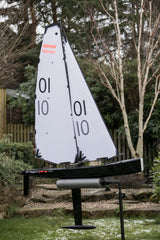 I didn’t wan’t to go any deeper than the DF65 fin so we need to find out how wide it needed to be to work in light winds, but narrow enough to minimise drag downwind. Dave Creed helped out here by moulding a couple of aerofoil section sleeves that slid over the fixed DF65 metal keel, they were fairly crude but easy enough for us to keep trimming down until we seemed to have the correct balance. Now we had a hull and foils that worked and that gave me the platform to develop the sail plan. It was at this early stage that I got Buzz Coleman involved. He’s an excellent skipper with a wealth of design and prototype production experience and is pretty handy on CAD design systems. I’m a graphic designer by trade, confident with 2D design software but detailed 3D work is a little beyond my pay grade. We had to rethink the hull lines when Joysway informed us that the minimum width they would be confident blow moulding would be 125mm. It was a pity to go away from the rather extreme shape of the first design but perhaps a slightly wider hull would have more rounded handling characteristics. At that point we also had a rethink about the overall length. As people got to hear about the project one of the first questions was always “will it measure as an IOM?”. We didn’t want that confusion and reduced the length to nine hundred and fifty millimetres, smaller than the IOM to position it below that class, leaving a clear upward progression for newcomers wanting to go further into t
I didn’t wan’t to go any deeper than the DF65 fin so we need to find out how wide it needed to be to work in light winds, but narrow enough to minimise drag downwind. Dave Creed helped out here by moulding a couple of aerofoil section sleeves that slid over the fixed DF65 metal keel, they were fairly crude but easy enough for us to keep trimming down until we seemed to have the correct balance. Now we had a hull and foils that worked and that gave me the platform to develop the sail plan. It was at this early stage that I got Buzz Coleman involved. He’s an excellent skipper with a wealth of design and prototype production experience and is pretty handy on CAD design systems. I’m a graphic designer by trade, confident with 2D design software but detailed 3D work is a little beyond my pay grade. We had to rethink the hull lines when Joysway informed us that the minimum width they would be confident blow moulding would be 125mm. It was a pity to go away from the rather extreme shape of the first design but perhaps a slightly wider hull would have more rounded handling characteristics. At that point we also had a rethink about the overall length. As people got to hear about the project one of the first questions was always “will it measure as an IOM?”. We didn’t want that confusion and reduced the length to nine hundred and fifty millimetres, smaller than the IOM to position it below that class, leaving a clear upward progression for newcomers wanting to go further into t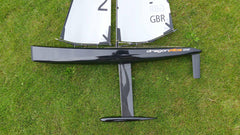 he sport. It would have been easy to go the other way, make it longer, putting it in direct competition with existing classes and that goes against the philosophy of DFs as readily available introductory racing yachts. So the hull got fleshed out and fine tuned for trim using all the CAD facilities available and knowing all the densities of the materials involved.
he sport. It would have been easy to go the other way, make it longer, putting it in direct competition with existing classes and that goes against the philosophy of DFs as readily available introductory racing yachts. So the hull got fleshed out and fine tuned for trim using all the CAD facilities available and knowing all the densities of the materials involved.
Compared to the DF65 this was such a leap forward in the time and resources we had available during the boat’s development, the complete boat, including every individual fitting was supplied to Joysway in CAD format, we had the time to properly test an accurate prototype on the water, superbly built in record time by Alex Cory. That final prototype and CAD files were handed over to Joysway at the January 2015 Nuremberg Show. I then had opportunity to contribute even further to the product by reverting back to my daytime occupation as a graphic designer and producing the rigging instructions and packaging design, very satisfying for me personally to see it all through in such detail. At the following years show the boat had just gone into production and was on display in it’s final form for the first time. Our first deliveries into the UK arrived later in April 2016.
One other design feature of the DF95, key to achieving the long waterline, lightweight boat idea, are the low aspect masthead rigs. “Is that the B rig” was often heard on peoples first sight of the boat. 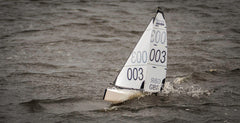 Conditioned to seeing the usual high aspect rigs on other classes it was an understandable response. I’ve lost count of the number of times I’ve had to explain the concept, but now, after eighteen months of DF95 fleet racing it’s totally accepted and understood. Amazing how quickly things change. The comparison of masthead to fractional rigs would warrant an article all of it’s own but I’m happy that I got the chance to incorporate them into what is now a mainstream class.
Conditioned to seeing the usual high aspect rigs on other classes it was an understandable response. I’ve lost count of the number of times I’ve had to explain the concept, but now, after eighteen months of DF95 fleet racing it’s totally accepted and understood. Amazing how quickly things change. The comparison of masthead to fractional rigs would warrant an article all of it’s own but I’m happy that I got the chance to incorporate them into what is now a mainstream class.
The DF65 version 6 and the A+ Rig
The DF65 all of a sudden looked a bit dated next to the shiny new DF95. It had been through five versions to improve certain areas and strengthen the hull moulding. With the ongoing success of the DF65, Joysway had the confidence to invest in much higher grade tooling for the DF95, confident that it would be worth the considerable investment required.  We knew what we really needed to do to bring the DF65 up to the standard of the 95. Joysway knew it as well, and offered to produce new tooling for it. We took it a stage further and discussed with them a complete makeover, improving the rig components, sail quality and just as importantly, the overall appearance of the whole package.
We knew what we really needed to do to bring the DF65 up to the standard of the 95. Joysway knew it as well, and offered to produce new tooling for it. We took it a stage further and discussed with them a complete makeover, improving the rig components, sail quality and just as importantly, the overall appearance of the whole package.
It was a golden opportunity but one thing could not change - the performance of the standard boat, it must not put any of the previous versions at any disadvantage, apart from cosmetically. Buzz and myself set about this redesign in the same way that we tackled the 95, I worked in 2D, we evaluated the designs and then produced final 3D files for all new components. Again, it was a year long process from agreeing the work to a production ready state. As in the 95s development we had access to 3D printing and Joysway were very quick to supply new hull mouldings for evaluation, when it finally went into production we’d tested it thoroughly and were confident that, although it almost looked like a new design, it’s performance was no better or worse than before, but I can’t help thinking that it looks faster, even before it hits the water. The rigging instructions and packaging also got refreshed as well. The version 6 was a big investment for Joysway and to their great credit did all this work at no significant price increase.
The DF65 has sold in amazing numbers since its launch in 2013, over twenty thousand boats to date. Incredible numbers, but it has failed to get a foothold into many notable countries that have predominantly light weather conditions. We all know it’s not a great light weather boat, but there was a simple fix for that, give it a bigger rig! A masthead design was the best way to achieve this, we didn’t want to go to a taller rig so we had to maximise the sail area within the existing rig height, the booms are slightly longer but the rig does fit into existing rig bags so portability has not been compromised. The rig is very effective up to around ten miles per hour winds, it will sail to windward in slightly stronger winds but getting downwind starts to get a little tricky. The standard A rig is good up to around eighteen miles per hour so it still has a very useful role to play. It has been, as expected, a controversial addition to the DF65, some clubs in the UK has decided to restrict their racing to the standard A rig, nobody is forcing the A+ on them and if the A rig suits the type of sailing they do with the DF65 then it’s fine with us. Nationally, in the UK, the A+ has been a class legal rig for most of the 2017 Travellers Series and those who’ve used it appreciate the better light wind performance. As time goes by I’m confident that it will be seen as a good thing and completes the DF65 package as an all-round performer and the A+ rig is not just a money making excersise as some of the forum posters would have you believe.
So where are we today and what does the future hold?
The DF95 came out as a well sorted boat right from the off, and since the introduction of the version 6, the DF65 has matured likewise. A period of product stability can now happen, Joysway and ourselves will monitor any issues and work to rectify any problems that may arise. These two classes are achieving what Mike and I dreamt of all those years ago. 
With a lot of hard work and Joysway’s amazing support, radio sailing has, over a very short space of time, gained two new classes positioned to facilitate the growth of the sport. But that won’t happen all by itself, what happens next is down you, the early adopters, the distributors and the core of enthusiasts that will come together to organise the classes on an international level. The boats are there, what you want to do with them is down to your own imagination.
When an International Class Association is formed one of it’s first objectives must be to stimulate the formation of national class associations where they don’t already exist in those countries that are already sailing DFs and encourage them to affiliate to their national radio sailing authorities. We’re all too happy to run events using the Racing Rules of Sailing, but these rules are owned by World Sailing and we should all respect that and do the right thing to legitimise their use.
I would love to see a new kind of international event, run as a kind of a radio sailing package holiday, bring the family and charter your equipment from the organisers. Imagine a four day break to say, Lake Garda in Italy, fabulous location, all accommodation, entertainment, racing available as part of the package, just bring some clothes, turn up and sign in to get your boats for the event. No expensive air cargo or waiting for your damaged rig box to appear on the baggage carousel - sounds good to me.
Happy sailing, John Tushingham, UK
